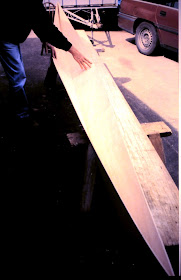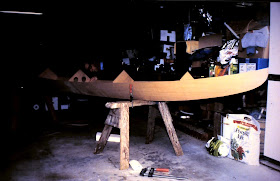Finntasia. The end of the innocence.
At 17 years of age I bought my first Finn. What a boat that was. Peter Morely was an ex NZ champ, his boat Finntasia was one of the oldest in the New Zealand fleet at that time, KZ7. He delivered it to our door in Waiake with his brand new Honda Accord which, he proudly announced, he had purchased with overseas funds, the only way to buy a new imported car at that time.
I on the other hand, had bought and ageing 1956 Vauxhall Velox, one year older than I was. It had only had one careful owner, a colleague of my father, who had brought it new into NZ. When it landed at Wellington docks, my father and he had caught the train to Wellington and had collected the car from customs. My father had his driver's licence so he drove it home, back to Auckland, with the owner as passenger. One year later I was born. Now, 17 years and 80,000 miles later, I owned the car.
I went to the Albany Auto Wreckers yard and selected a tow bar from a derelict Vauxhall of the same year as mine, unbolted it, paid for it and took it home. I drilled the holes, fitted the bolts, connected the wires and presto, I was ready to tow my new-old Finn wherever I wanted, whenever I wanted. Fuel was 55 cents for 4 litres from memory. I named my new-old car "Barrymore" after the drummer from Jethro Tull whom I greatly admired.
Finntasia was poorly painted in Kermit Green, not my colour. I applied a fresh, gloss coat of British Racing Green, much more my style and she looked amazing! Finntasia immediately caught the eye of my new friend Mike Toy. He liked the colour too. He made me an offer I could not refuse so before long I was looking for anther boat.
 |
| The author sailing Tarkus off Waiake Beach, 1976 |
Tarkus, a much newer Finn, painted a beautiful powder blue with dark varnished wooden deck, built by the famous Elder of Christchurch became available and I bought her, she had a new Needle Spar aluminium mast and new Elvstrom sail, this was what I wanted. Mike and I became inseparable in spite of our 19 year age difference. We sailed everywhere together, each in our own boat. We thought nothing of sailing to Tiritiri Matangi and back of an afternoon. During this period we hatched a plan to collaborate on the building of an experimental boat, a Micronesian style Proa adapted by Mike to his own design. This story will form the basis of chapter 5.
See the full story of this collaborative project on my blog:
http://harmenhielkema.blogspot.com/2008/04/takapu-proa-dissertation.html
I began to race Tarkus locally but could not compete with the new fibreglass boats that were coming out of Europe. This was a disappointment to me so, at the end of the season, I decided to search for local competition. I travelled far and wide, from Porirua in the south to Houhora Harbour in the north and everywhere in between, New Plymouth, Napier, Taupo, Tauranga, Manukau, Whangarei. Local clubs in Birkenhead and Waiuku had fleets of older Finns and I enjoyed the casual racing they offered.
By now I had quit Teacher's Training College after only completing half the course. I did not enjoy the profession at all. I had followed my father's advice and not my heart. Still avoiding my true calling I took a job at Brisc Marine as a shop salesman and in-store ticket writer, not an illustrious start but a start in something I knew and understood, boats.
My beautiful olive green car, my ticket to freedom was written off one morning. On the way to work I made my usual stop at the top of Beach Road to pick up my old friend Mike Williams. From time to time I would drop him off at the Auckland University where he was studying for a degree in quantum mechanics and mathematics. Mike was about to open the passenger door when he suddenly looked to his right and took a big step backwards as a Holden Monaro drove into my car at 40 miles per hour. The enormous impact carried me and my heavy old relic 20 meters down the road. The back of my seat collapsed and my head went through the skin of my bass drum which was in the back seat. I was knocked unconscious and was bleeding from a head wound. I came to to the sound of loud voices, a local man, Mr R, had rushed from his house to see what the cause of the loud bang had been. In the meantime the upset owner of the Monaro had it in his head that I was responsible for the crash and was in the process of hauling my unconscious body out of the car to give me a good beating! Fortunately for me Mr R, who was confident and powerfully built, restrained the angry driver until the police arrived. I had a brief period of recovery at home from my head injury much to the chagrin of my employers.
The result of this accident for me was ongoing problems with concentration and headaches. Neither the driver of the Monaro nor I were insured. There was no chance of recovering anything from him without taking court action which I could not afford so I was forced to regroup. He was eventually charged with dangerous driving.
Public transport was now my only way to get to work. On the bus I met a beautiful young woman. We travelled together daily, she always kept a seat for me. I liked her, she had long blond hair, light blue eyes and a dusting of freckles across her cheeks. I made her smile with stories of my recent adventures and tried to convince her to come tramping with me that winter on the High Plateau of the central North Island, something I did every winter when I wasn't sailing. She was quite timid about that idea, she was a librarian and not inclined to do anything too adventurous she told me. She did invite me to dinner though.
L lived in Waiake, near the beach, alone in a little Fibrolite clad cottage with her Doberman Pincer called Bunny Rabbit. She invited me in and we sat in the lounge chatting about our day with the dog sitting right next to me. We ate the meal that she had prepared, on our laps, there was no need for a pre rinse for the dishes, Bunny Rabbit saw to that. After dinner she told me she was going out of the room for a moment. When she returned she was perfectly naked. I'll never forget how she looked as she walked across the room towards me, took me by the hand and lead me to her bedroom. She had a beautiful pink scar which ran from hip to hip that looked for all the world as if she had been welded back together by a skilled engineer. I thought nothing more of it at the time. When we awoke in the morning it was still dark. At that time I was still living at home and I needed to get back for fresh clothes and a shower before running to catch the bus to get to work in the city.
I remember walking home in the dark that morning with the sun just staining the eastern sky, my mind had been blown wide open. I was ecstatic, confused, overjoyed to the extent that I could not focus on anything else.
When I climbed aboard the bus that morning L was not there in her usual seat. Nor was she there the following day or the one after that. I had hardly slept but I imagined that she may have been unwell, she had no telephone line on which to call her. I finally decided to pay her a visit at the little cottage. I knocked on the door but got no reply. I looked through the window into the lounge where we had shared a meal only a few nights before, it was completely bare, no furniture, nothing. She had gone and I was devastated, I had no clue as to what had happened to her. This confused me even more. I can't easily describe what I felt but I was badly upset. I resigned my self to checking at the Library that day after work.
I had been so distracted by what had happened to me that I could not concentrate on my job. The sales manager took me aside and suggested I find some work that might suit me better. I did not argue with him, he was right, the work did not suit me, I simply burst into tears, I gathered my things and walked away across town to look for L at the Auckland Library. I knew Colleen the head librarian there, she was a near neighbour of ours in Torbay and a sympathetic friend who was aware of my connection with L. She informed me that L had resigned a couple of days before, had made no explanation and left no forwarding address for herself. I had no further contact with L except that one day, some weeks later, I received a parcel in our letter box. It was a heavy book wrapped in brown paper, it contained note with a few words hastily scribbled onto a piece of note paper.
"Sorry I left so unexpectedly, here's a book I thought you might like. Much Love, L"
Nothing more. The package contained an expired library book written by Howard Williams called "Sails." It was the bible of sailmakers worldwide at the time. I still have that copy, who knows what happened to the note.
Some months later I was rigging my boat at the beach, it was early on a Saturday morning. In the distance I noticed a young couple walking a doberman pincer along the beach towards me with a small child about 3 years of age. As they approached I saw that it was L! She noticed me with a shock but walked shyly past me with her companion, a tall dark hared, bearded man who I thought looked significantly older than her. She walked past me without as much as raising her eyes, she never once looked back and I never laid eyes on her again.













































